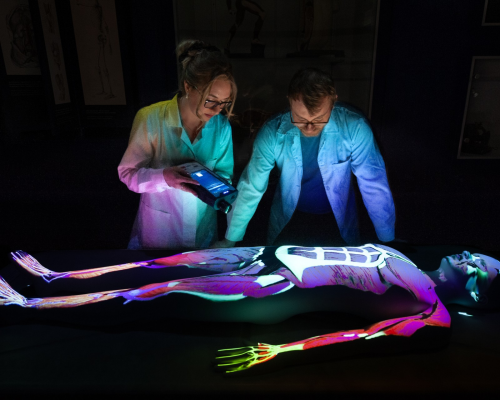Reading from the light
Reading time: about 5 minuts

Every year, medical diagnostics are getting better and better thanks to the tremendous development of new methods that enable the precise detection of the many different molecules present in biological fluids during an infection. Nevertheless, the rapid and even real-time analysis of bacterial, fungal, or viral infections is still far from ideal, which is why many efforts are being made around the world to improve methods that could enable the fastest and least invasive diagnosis of infections of various aetiologies. Recently, scientists at the Institute of Physical Chemistry of the Polish Academy of Sciences led by prof. Agnieszka Kamińska presented an effective way to distinguish the type of infection in biological fluids using the diagnostic technique of surface-enhanced Raman scattering. They have successfully unravelled the complexities in the area of rapid diagnosis of fertility and disease in women. fluids. Let's take a closer look at their discovery.
Prior to their study, fertility awareness-based methods (FABM) remained one method of increasing the chances of conception by differentiating cervical mucus monitoring (CMM). Unfortunately, this method only shows more accurate results for fertile couples and not for infertile couples. As with fertility, microscopic analysis of Gram-stained vaginal discharge to visualise the specific causative agent is the most commonly used diagnostic method. Although attempts have been made to address cervical cancer and human papilloma virus (HPV) infection using Raman and related methods, the problem of infertility as well as vaginal infection using such a technique remains a mystery.
The results demonstrated by the researchers from the IPC PAS were based on tracking the spectral response of fluids from the female reproductive tract, including three types of fluids, i.e., vaginal fluid, menstrual fluid, and menstrual spotting using surface-enhanced Raman spectroscopy (SERS) and a chemometric method, which together provide insight from the molecular level into the composition of vaginal secretions. As the composition of vaginal fluids is complex, in which many compounds such as organic acids, pyridine, vaginal peptidase, lipids, phospholipids, amino acids, fatty acids, carbohydrates, glycoproteins, proteins, and immunoglobulins can be found, it can also be enriched with other specific molecules including hormones depending on the phase of the menstrual cycle, making it difficult to accurately diagnose infection at an early stage or recognize the aetiology.
Nevertheless, the proposed methods allow diagnosis in the fertile and infertile phases with high precision without affecting signals of hormonal imbalance in the body. And all thanks to measurements of the interaction of matter with light, where the unique bands for particular vibrations of molecules were measured. Diagnostics with the proposed tools were carried out for two independent menstrual cycles in which the patients were both healthy and struggling with infections such as vulvovaginal candidiasis, bacterial vaginosis, gonorrhoea, and had co-infection. Because the researchers optimised the analytical conditions for precise measurement of spectra and implemented algorithms to adapt SERS to different biological aspects of detection, their diagnostic tool does not require pre-treatment of samples, labelling or swabbing, making it much simpler and less expensive compared to classical diagnostic tests.
In the word of the lead author of the team “We investigated the spectral manifestation of hormonal changes and vaginal inflammation and made SERS time-dependent analysis of clinical material taken from biological fluids during full menstrual cycles as well as those struggling with different types of infections including bacterial, fungal, coinfections and gonorrhoea. The spectral analysis was supported with the Partial Least Square Regression (PLSR) method to gain deeper insight into the spectra and find differences not visible to the naked eye”.
In addition to the economic and operational advantages, SERS diagnostics can be performed throughout the menstrual cycle, making it a step forward in the diagnosis of many other diseases that may be influenced by many different hormones in biological fluids. The study showed that the intensity of the relevant hormones (e.g. luteinising hormone (LH), folliculotropic hormone (FSH), progesterone and oestradiol), which is closely correlated with follicle formation and rupture when fertilisation does not occur, can be characterised using the SERS technique. Therefore, the information recorded on the spectra and caused by the day of the menstrual cycle does not affect the reading of the condition due to the specific associations of the spectral data and the PLSR analysis used.
“Our studies show that vaginal infections lead to a more significant spectral effect than the menstrual cycle. Infection can be recognized by time-dependent SERS analysis through the presence of characteristic features that provide spectral insight into the molecular pattern of fluids even in very complex biological fluids”. – remarks the first author Sylwia M. Berus.
The results presented here provide an important basis for research that will include detailed SERS analysis of aetiological agents in relation to the diagnosis of vaginal infections. Furthermore, the proposed technique is a powerful and promising tool for rapid and non-invasive analysis even in forensic investigations. Their work is published in Sensors and Actuators B: Chemical (https://doi.org/10.1016/j.snb.2024.135571) and was financed by the National Science Center under grant PRELUDIUM-20 (2021/41/N/ST4/02164).
CONTACTS:
Prof. Agnieszka Kamińska
Institute of Physical Chemistry of the Polish Academy of Sciences
Phone: +48 22 343 33 12
email: akaminska@ichf.edu.pl
SCIENTIFIC PAPERS:
“Surface-enhanced Raman spectroscopy analysis of menstrual cycle: From biochemical changes to diagnostics of vaginal infections”
Sylwia M. Berus, Beata Młynarczyk-Bonikowska, Grażyna Przedpełska, Tomasz Szymborski, Agnieszka Kamińska
Sensors and Actuators B: Chemical. 2024, 409,135571
https://doi.org/10.1016/j.snb.2024.135571
- Author: Dr Magdalena Osial
- Contact: magdalena@osial.eu
- Photo source: Grzegorz Krzyzewski
- Date: 29.05.2024







